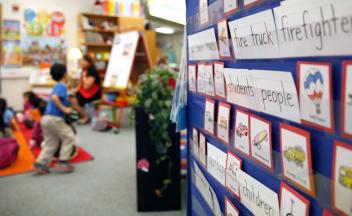Oral vocabulary refers to words that we use in speaking or comprehend in listening. Reading vocabulary refers to words we comprehend or use in print. In the Simple View of Reading, which describes reading as having two basic components — word recognition and comprehension — vocabulary falls under language comprehension.
Certificate of Completion
After completing this module and successfully answering the post-test questions, you’ll be able to download a certificate of completion.
Average time to complete: 6 hours
Vocabulary plays an important part in learning to read. Beginning readers must use the words they hear orally to make sense of the words they see in print.
Consider, for example, what happens when a beginning reader comes to the word dig in a book. As she begins to figure out the sounds represented by the letters d, i, and g, the reader recognizes that the sounds make up a very familiar word that she has heard and said many times. It is harder for a beginning reader to figure out words that are not already part of her speaking (oral) vocabulary.
Furthermore, as children advance to reading longer, more complex types of words, many English words have more than one plausible phonetic pronunciation. For example, canopy could be cuh-NOP-ee instead of CAN-up-ee; timid could be pronounced with a long i in the first syllable (like time – id) instead of with a short i. If children already have these words in their oral vocabularies, it will be easier for them to read the words correctly.
Vocabulary is also very important to reading comprehension. Readers cannot understand what they are reading without knowing what most of the words mean. As children learn to read more advanced texts, they must learn the meaning of new words that are not part of their oral vocabulary.
Four types of vocabulary
- Listening vocabulary: the words we need to know to understand what we hear
- Speaking vocabulary: the words we use when we speak
- Reading vocabulary: the words we can read and understand
- Writing vocabulary: the words we use in writing
In assessment of vocabulary in beginning or struggling readers, use of an oral measure (listening and/or speaking vocabulary) is very important. A written measure of vocabulary will confound vocabulary knowledge with reading skills.
For instance, if a student who struggles with decoding gets a low score on a vocabulary measure that requires reading, it will be difficult to know whether the low score actually reflects vocabulary limitations or merely the fact that the child could not decode the words on the test.
Semantic gradients
Semantic gradients are a way to broaden and deepen students’ understanding of related words. It helps students distinguish between shades of meaning and allows them to be more precise and imaginative in their writing.
